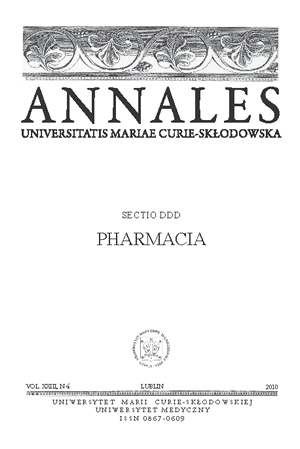Total intake of zinc, manganese, copper, vitamin C and phenols in students` daily food rations
Keywords:
diets, zinc, manganese, copper, vitamin C, polyphenolsAbstract
In 2009 and 2010, based on dietary recall, duplicates of daily food rations of 536 randomly chosen students from the Medical University of Lublin, University of Natural Sciences and Catholic University in Lublin were investigated. The levels of zinc, manganese and copper were determined by flame atomic spectrometry and estimated using the DIETETYK 2006 software. Moreover, the intake of vitamin C, total energy of diets, energy derived from proteins, fats and carbohydrates were calculated and the sum of phenol compounds determined using the Folin-Ciocalteu reagent. The findings demonstrate that dietary habits should be modified in relation to energy values of diets and the proportion of fats. The intake of mineral components does not carry the health risks in the light of present dietary reference intakes (DRI) values while the intake of vegetables, fruit and tea should be increased amongst male students as their diets contain too low amounts of antioxidants.
References
1. Chalcarz W., Merkiel S., Tyma M.: Spożycie witamin i składników mineralnych przez kolarzy górskich. Bromat. Chem. Toksykol., 41, 686, 2008.
2. Charkiewicz A.E. et al.: Składniki mineralne i witaminy w diecie uczniów zespołu szkół gastronomicznych w Białymstoku. Bromat. Chem. Toksykol., 41, 663, 2008.
3. Dietary Reference Intakes for Viamin A, Vitamin K, Arsenic, Boron, Chromium, Copper, Iodine, Iron, Manganese, Molybdenum, Nickel, Silicon, Vanadium and Zinc. (2001) Food and Nutrition Board Institue of Medicine. National Academy Press, Washington, D.C.
4. Ilow R. et al.: Evaluation of bioflavonoids intake in the diets of 50-year-old inhabitants of Wrocław. Adv.Clin.Exp.Med., 17, 327, 2008.
5. Jarosz M. et al.: Normy żywienia człowieka. Podstawy prewencji otyłości i chorób niezakaźnych. Warszawa, PZWL, 2008.
6. Król E., Krejpcio Z.: Ocena sposobu żywienia wybranej grupy ludzi młodych. Bromat. Chem. Toksykol., 41, 911, 2008.
7. Kunachowicz H. et al.: Tabele składu i wartości odżywczej żywności. Warszawa. PZWL 2005.
8. Lebiedzińska A. et al.: Ocena sposobu żywienia kadry narodowej polskich lekkoatletów. Porównanie wyników badań analitycznych z oceną teoretyczną. Bromat. Chem. Toksykol., 41, 428, 2008.
9. Marzec Z. et al.: Ocena wartości energetycznej oraz pobrania wybranych pierwiastków i witaminy C z całodziennymi dietami studentów. Bromat. Chem. Toksykol., 41, 433, 2008.
10. Marzec Z., Koch W.: Total intake of selected elements with students’ daily food rations with mineral supplementation considered. Annales UMCS s. DDD., 21, 329, 2008.
11. Olędzka R. et al.: Ocena jakościowa i ilościowa sposobu żywienia studentów Wydziału Farmaceutycznego Akademii Medycznej w Warszawie w zależności od roku studiów i miejsca zamieszkania w latach 1997/1998 i 1999/2000. Bromat. Chem. Toksykol., 36 (supl.). 237, 2003.
12. Pasternak K., Horecka A., Kocot J.: Biochemistry of zinc. Annales UMCS, sect. DDD., 23, 19, 2010.
13. Singleton V.L.: Analysis of total phenols and other oxidation substrates and atioxidants by means of Folin-Ciocalteu reagent. Methods Enzymol., 30. 233, 1999.
14. Stanisz A.: Przystępny kurs statystyki w oparciu o program STATISTICA PL na przykładach z medycyny. StatSoft Polska, Kraków 1998.
15. Waśkiewicz A, Sygnowska E: Jakość żywienia dorosłych mieszkańców Polski w aspekcie ryzyka chorób układu krążenia- wyniki badania WOBASZ. Bromat. Chem. Toksykol., 41, 395, 2008.
16. Zając M et al.(2000). Witaminy i mikroelementy. Kontekst, Poznań 2000.
Downloads
Published
Issue
Section
License
Copyright (c) 2010 Authors

This work is licensed under a Creative Commons Attribution-NonCommercial-NoDerivatives 3.0 Unported License.


